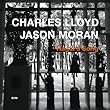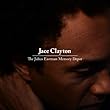 On The World According to Andy Bey, the songs assume a coherent, intelligent caring sensibility and subject, a world in which relationships matter—even if and when relationships are troubled. Love is seen as many things: infatuation, lust, compassion, faith, loyalty, understanding, care, dedication. Meaning is preferred to nihilism. Who or what brings knowledge and joy? What allows people to become themselves? We are encouraged to consider such questions.
On The World According to Andy Bey, the songs assume a coherent, intelligent caring sensibility and subject, a world in which relationships matter—even if and when relationships are troubled. Love is seen as many things: infatuation, lust, compassion, faith, loyalty, understanding, care, dedication. Meaning is preferred to nihilism. Who or what brings knowledge and joy? What allows people to become themselves? We are encouraged to consider such questions.
Category: Music reviews
Legacy and Love, Memory and Music: George Benson, Inspiration: A Tribute to Nat King Cole
 Throughout the album, George Benson’s guitar playing is soulful and supple—the notes are clear, concentrated, and sensuous. Through his playing and the warmth of his singing—and energetic scatting—Benson, supported by the trumpet of Wynton Marsalis, makes Cole’s signature song “Unforgettable” —a composition by Irving Gordon—now Benson’s to claim. “When I Fall in Love” is a traditionally lush romantic duet, with Idina Menzel, a performer in theater, film, and television.
Throughout the album, George Benson’s guitar playing is soulful and supple—the notes are clear, concentrated, and sensuous. Through his playing and the warmth of his singing—and energetic scatting—Benson, supported by the trumpet of Wynton Marsalis, makes Cole’s signature song “Unforgettable” —a composition by Irving Gordon—now Benson’s to claim. “When I Fall in Love” is a traditionally lush romantic duet, with Idina Menzel, a performer in theater, film, and television.
Out of Tenderness and Wisdom: Ramzi Aburedwan, Reflections of Palestine
 Bouzouk-player Ramzi Aburedwan’s Reflections of Palestine reminds me a little of Spanish music. (Could it be that the Middle East influenced Spain? Yes.) Music is almost always a shared thing, a common treasure. I can’t say this music is calming, as it is full of detail, intensity, shifts, requiring attention—but it is enriching.
Bouzouk-player Ramzi Aburedwan’s Reflections of Palestine reminds me a little of Spanish music. (Could it be that the Middle East influenced Spain? Yes.) Music is almost always a shared thing, a common treasure. I can’t say this music is calming, as it is full of detail, intensity, shifts, requiring attention—but it is enriching.
The Return of a Prodigy: Shuggie Otis, Inspiration Information/Wings of Love
 The now lean, soft-spoken and austere but friendly loner Shuggie Otis’s Wings of Love, the new companion to Inspiration Information, answers a lot of historical questions about the creative interests and development of the musician.
The now lean, soft-spoken and austere but friendly loner Shuggie Otis’s Wings of Love, the new companion to Inspiration Information, answers a lot of historical questions about the creative interests and development of the musician.
Beauty, Contrast, Speed, Unity: Charles Lloyd and Jason Moran’s Hagar’s Song
 The boy prodigy Charles Lloyd, now a musical elder, was born in the late 1930s and mentored by pianist Phineas Newborn, and Lloyd worked with B.B. King and Howlin’ Wolf, before graduating from the University of Southern California with a master’s degree.
The boy prodigy Charles Lloyd, now a musical elder, was born in the late 1930s and mentored by pianist Phineas Newborn, and Lloyd worked with B.B. King and Howlin’ Wolf, before graduating from the University of Southern California with a master’s degree.
Confident, Sensual, Soulful Singer-Songwriter: Kail Baxley, Heatstroke/The Wind and the War
 One discerns the different influences on the singer-songwriter; and Kail Baxley’s voice, solitary and soulful, is a strong voice that sounds traditional and reminds this listener of Chris Whitley and Amos Lee. “Say Goodbye to the Night” is both confident and melancholy, with Baxley’s deep voice inside a pleasant rhythm.
One discerns the different influences on the singer-songwriter; and Kail Baxley’s voice, solitary and soulful, is a strong voice that sounds traditional and reminds this listener of Chris Whitley and Amos Lee. “Say Goodbye to the Night” is both confident and melancholy, with Baxley’s deep voice inside a pleasant rhythm.
Earthy Pleasure Beyond Conflict and Poverty: Cedric Watson and Corey Ledet’s Goin’ Down to Louisiana
 The divergent rhythms in “Ma Negresse” give the composition its complexity and charm, whereas “Black Snake,” with drumming by Brad Frank, has a country blues feel. Watson’s fiddle is the dominant force in the old-fashion country dance song “Calinda.” The tempo is fast and sends “Madame Faielle” reeling with a lot of energy; and although the song has some lyrics, it is mostly instrumental.
The divergent rhythms in “Ma Negresse” give the composition its complexity and charm, whereas “Black Snake,” with drumming by Brad Frank, has a country blues feel. Watson’s fiddle is the dominant force in the old-fashion country dance song “Calinda.” The tempo is fast and sends “Madame Faielle” reeling with a lot of energy; and although the song has some lyrics, it is mostly instrumental.
A Master of Melody and Swing: Kermit Ruffins and his Happy Talk
 Anyone who has heard of the talented, improvising trumpeter Kermit Ruffins, a friendly sensualist, and one of the founders of the Rebirth Brass Band, as well as a respected barbecue grill man, knows that those who love the trumpeter’s work consider him an embodiment of the spirit of New Orleans.
Anyone who has heard of the talented, improvising trumpeter Kermit Ruffins, a friendly sensualist, and one of the founders of the Rebirth Brass Band, as well as a respected barbecue grill man, knows that those who love the trumpeter’s work consider him an embodiment of the spirit of New Orleans.
Loss and Sorrow in the Words of Soldiers: David T. Little, Soldier Songs
 Soldier Songs begins and ends with gong-like sounds, which could be large mortar explosions. There are quotes from soldiers about the life-or-death circumstances of war as killing; and making oneself available to die upon orders; and the (usually forbidden) permission to kill. An experimental classical sound supports the ordinary conversation of the soldiers’ testimonies: piano, drone, and pulsing rhythm accompany the voices.
Soldier Songs begins and ends with gong-like sounds, which could be large mortar explosions. There are quotes from soldiers about the life-or-death circumstances of war as killing; and making oneself available to die upon orders; and the (usually forbidden) permission to kill. An experimental classical sound supports the ordinary conversation of the soldiers’ testimonies: piano, drone, and pulsing rhythm accompany the voices.
A Complex Figure, a Tragic End: The Julius Eastman Memory Depot by Jace Clayton
 as Eastman too radical for the avant-garde? Was the Cage-Eastman argument the inevitable clash of a privileged self-erasing artist and an ambitious but rebellious self-asserting artist? Did Eastman betray himself by adopting the destructive and distracting, false, hateful, and self-indulgent racial and sexual identity politics of the time?
as Eastman too radical for the avant-garde? Was the Cage-Eastman argument the inevitable clash of a privileged self-erasing artist and an ambitious but rebellious self-asserting artist? Did Eastman betray himself by adopting the destructive and distracting, false, hateful, and self-indulgent racial and sexual identity politics of the time?